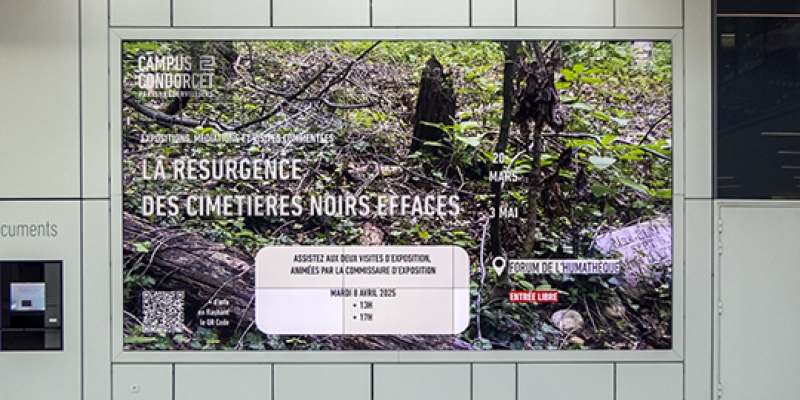
Thursday, April 17th, 2025
French Researcher Explores "Erased" U.S. Black Cemeteries
Cover image: Digital display for The Resurgence of "Erased" Black Cemeteries
© Entrée to Black Paris
ETBP co-owner Tom Reeves recently attended a presentation for an exhibition entitled La Resurgence des Cimetières Noirs Effacés (The Resurgence of "Erased" Black Cemeteries).*
It was given by the exhibition's curator, Pauline Peretz, at the Humathèque library of the Condorcet Campus of L'École des hautes études en sciences sociales (EHESS)** in the Paris suburb of Aubervilliers.
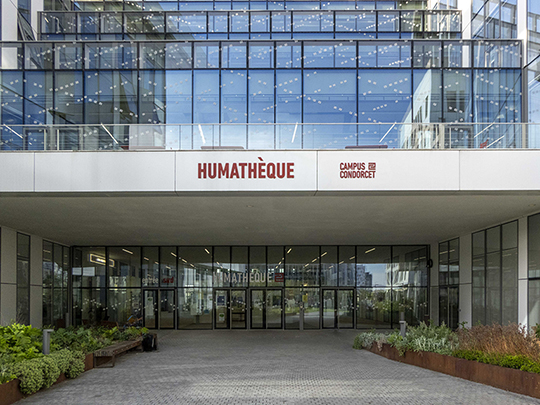 Humathèque library at Campus Condorcet
Humathèque library at Campus Condorcet
© Entrée to Black Paris
Curator Peretz became interested in this topic after having read an article in the September 2021 issue of the New Yorker by Harvard historian Jill Lepore. Lepore's question—"Who will speak for the dead?"—struck a cord with her.
Peretz and her colleague, Endika, spent the summers of 2022 and 2023 traveling the U.S. South to research and photograph the locations featured in the exhibition, which consists of a series of photographs and descriptive text (in French) posted to large panels in the center of the great entrance hall of the library.
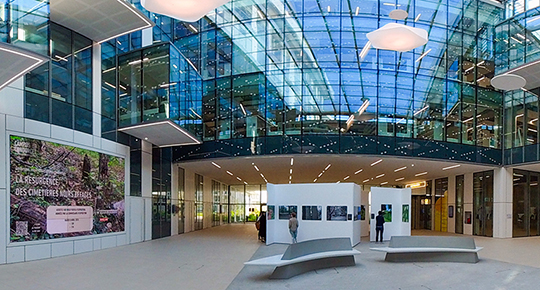 Resurgence at the Humathèque library
Resurgence at the Humathèque library
© Entrée to Black Paris
During her 90-minute presentation, Peretz walked to each panel and talked about eleven cemeteries that had been forcibly abandoned, forgotten or "erased" due to construction projects, then rediscovered. In the photograph below, she is talking about Zion Cemetery in Tampa, Florida.
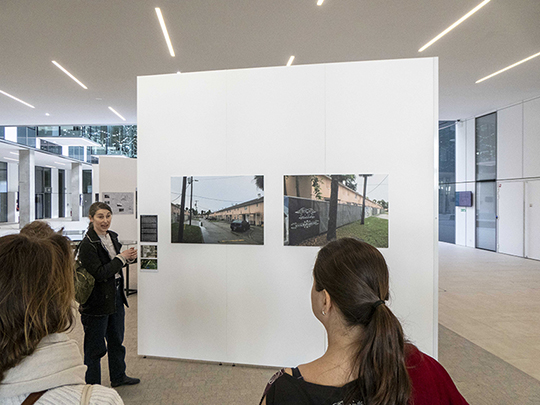 Pauline Peretz talks about Zion Cemetery
Pauline Peretz talks about Zion Cemetery
© Entrée to Black Paris
Founded by an African-American businessman in 1901, Zion Cemetery was sold in the 1920s when the owner could not pay the taxes that the city illegally imposed upon him. During the 1950s, the city built an apartment complex on the land.
In 2019, while consulting city directories, a Tampa Bay Times journalist named Paul Guzzo realized that Robles Park Village had been built over the burial ground. It was constructed as housing for middle class whites and is now largely abandoned. The current residents of the complex are African-American.
Today, there is an ongoing effort by the Zion Cemetery Preservation and Maintenance Society and the Tampa Housing Authority to find ways to commemorate the space and the memory of those interred there.
Another cemetery featured in the exhibition is Shockoe Hill African Burying Ground in Richmond, VA.
Located near Hebrew Cemetery and Shockoe Hill Cemetery, which are well preserved historic sites, the burying ground lies beneath an abandoned gas station that has been painted to commemorate its existence. The information panel for the African Burying Ground summarizes particularly grim details regarding the desecration of its tombs while it was still active (1816-1879), followed by its decline and disappearance.
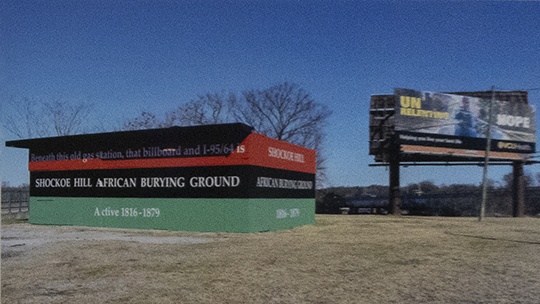 Detail of exhibition photo of gas station at Shockoe Hill African Burying Ground
Detail of exhibition photo of gas station at Shockoe Hill African Burying Ground
Exhibition photo by Endika
Image by Entrée to Black Paris
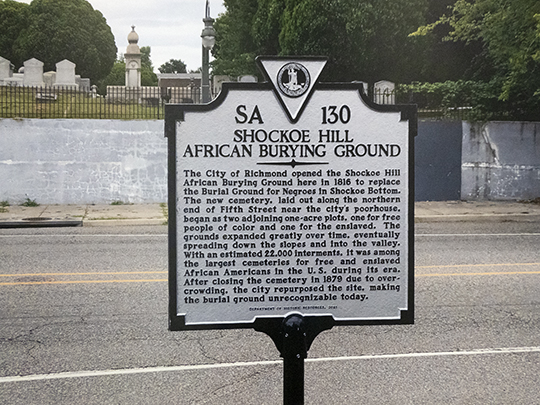 Detail of exhibition photo of marker at Shockoe Hill African Burying Ground
Detail of exhibition photo of marker at Shockoe Hill African Burying Ground
Exhibition photo by Endika
Image by Entrée to Black Paris
Thanks to the efforts of Lenora McQueen, a Texan who found evidence that three of her ancestors were buried at the Virginia site, the African Burying Ground and the neighboring cemeteries have been added to the National Register for Historic Places as the Shockoe Hill Burying Ground Historic District.
Resurgence presents information about multiple cemeteries in Florida and Virginia, as well as College Memorial Park Cemetery in my hometown of Houston, TX.
A glass display table contains newspaper clippings about the conflicts surrounding the discovery of the African Burial Ground in Manhattan in 1991.
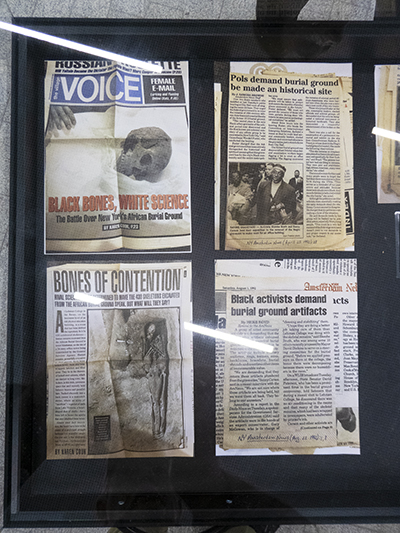
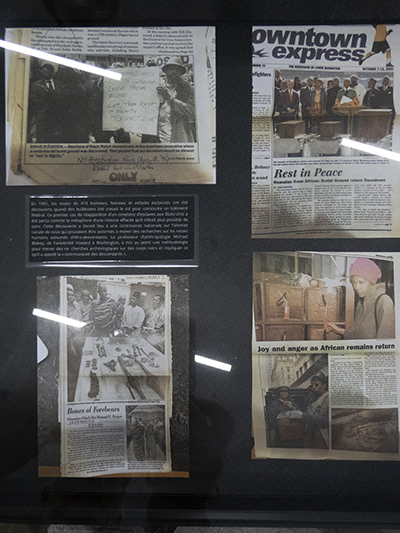
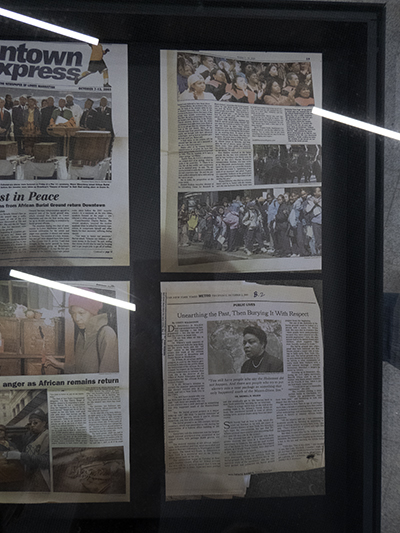 Display table of newspaper articles re: African Burial Ground in Manhattan
Display table of newspaper articles re: African Burial Ground in Manhattan
Images © Entrée to Black Paris
The Resurgence of "Erased" Black Cemeteries will be on display through May 3, 2025.
*Much of the information presented in this exhibition was published in L'Histoire N° 526 in December 2024.
**L'EHESS is the first urban campus devoted to the humanities and social sciences in France and in Europe. Recently constructed, it is where the closing event for the Paris Noir colloquium was held on March 22, 2025.

 Our Walk: Black History in and around the Luxembourg Garden - Click here to book!
Our Walk: Black History in and around the Luxembourg Garden - Click here to book!